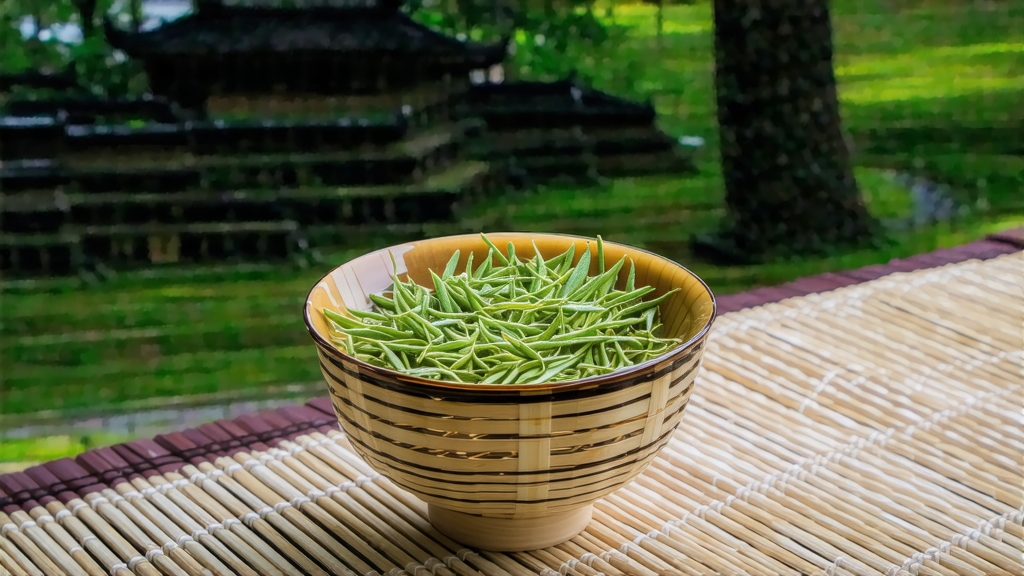
Tucked high on the northern rim of the Sichuan Basin, where humid clouds from the Yangtze collide with cold Himalayan winds, lies Meng Ding Mountain, the legendary birthplace of the world’s first cultivated tea garden. Among the ten thousand bushes that cloak its granite spires, only a handful of ancient trees still yield the downy, jade-yellow buds that became the tribute known as Meng Ding Huang Ya—Meng Ding Yellow Bud. For thirteen centuries this tea was carried by mule and sedan chair to the imperial court, wrapped in yellow silk, the color reserved for the Son of Heaven. Today the same buds, plucked in a fleeting two-week window each spring, remain one of China’s rarest yellow teas, produced in batches so small that most Chinese tea lovers have never tasted an authentic sample, let alone the global market.
Historical scrolls record that the monk Wu Lizhen planted the initial seven tea bushes on Meng Ding in 53 BCE, making them the oldest known Camellia sinensis cultivars still surviving in situ. By the Tang dynasty (618-907 CE) the buds were already taxed as “royal tea,” and the Song emperor Huizong—himself a skilled tea artist—decreed in 1107 that only yellow tea from Meng Ding could be offered at the ancestral altar. The Ming revised the tribute schedule, demanding 400 kilograms annually, an impossible quota that forced farmers to refine the slow “sealed yellowing” technique that distinguishes the category. When the Qing court switched to dark Pu-erh in the eighteenth century, Meng Ding Huang Ya vanished from palace records, surviving only in monastery cellars and local memory until a 1959 state expedition rediscovered 38 ancient mother trees. Cuttings from those venerable ancestors now propagate the restricted 120-hectare appellation, still harvested by hand at dawn when the mountain’s dew carries the scent of wild orchid.
Although all yellow teas share the defining “men huang” or “sealed yellowing” step, Meng Ding Huang Ya occupies the most delicate pole of the spectrum. It is classified as “bud yellow tea,” meaning only the unopened spear-shaped tip and its first miniature leaf are taken. Pickers climb 1,400-meter slopes before sunrise, selecting buds that are exactly 18–22 mm long, still translucent with moonlight moisture. A single kilogram requires 42,000 plucks, roughly one morning’s work for six experienced women who sing in antiphonal chorus to keep their fingers nimble.
The craft begins the moment the basket descends to the mountain’s stone courtyards. First, the buds are spread on ramie mats for three hours of “kill-green” at 160 °C, a wok-firing that is lighter than green tea because the goal is to arrest oxidation, not drive off all moisture. While the leaves are still warm, they are wrapped in thick cotton cloth and placed inside a bamboo drum lined with wet rice paper. Here the magic of men huang occurs: over the next 48 hours the bundle is opened every six hours to release trapped carbon dioxide, then re-wrapped with gradually decreasing humidity. The leaf slowly suffocates and re-absorbs its own aromatic compounds, turning from jade to pale primrose while developing the distinctive “chestnut-orchid” fragrance impossible to replicate in green tea. Finally the processor rolls the buds on a shallow wicker tray for exactly 1,200 circular motions—counted aloud—before a gentle 60 °C bake dries them to 4 % moisture. The finished needle is straight, silvery-yellow, and so fragile it snaps at the pressure of a fingernail.
Because the leaf is minimally rolled, Meng Ding Huang Ya demands a brewing approach closer to white tea than to green. The ideal vessel is a tall glass gaiwan (120 ml) that allows the buds to stand upright like miniature golden pagodas. Water should be drawn from limestone-rich springs, filtered but not distilled, and cooled to 78 °C; hotter temperatures extract bitter tannins masked during men huang. After pre-warming the glass, 3 g of buds are dropped in, followed by 30 ml of water to “awaken” the leaf for ten seconds. The first formal infusion fills the gaiwan to the brim and steeps 45 seconds; subsequent infusions add five seconds each. Watch as the buds swell, turning translucent green at the base while the tip remains golden—a living barometer of mountain terroir.
The liquor is the color